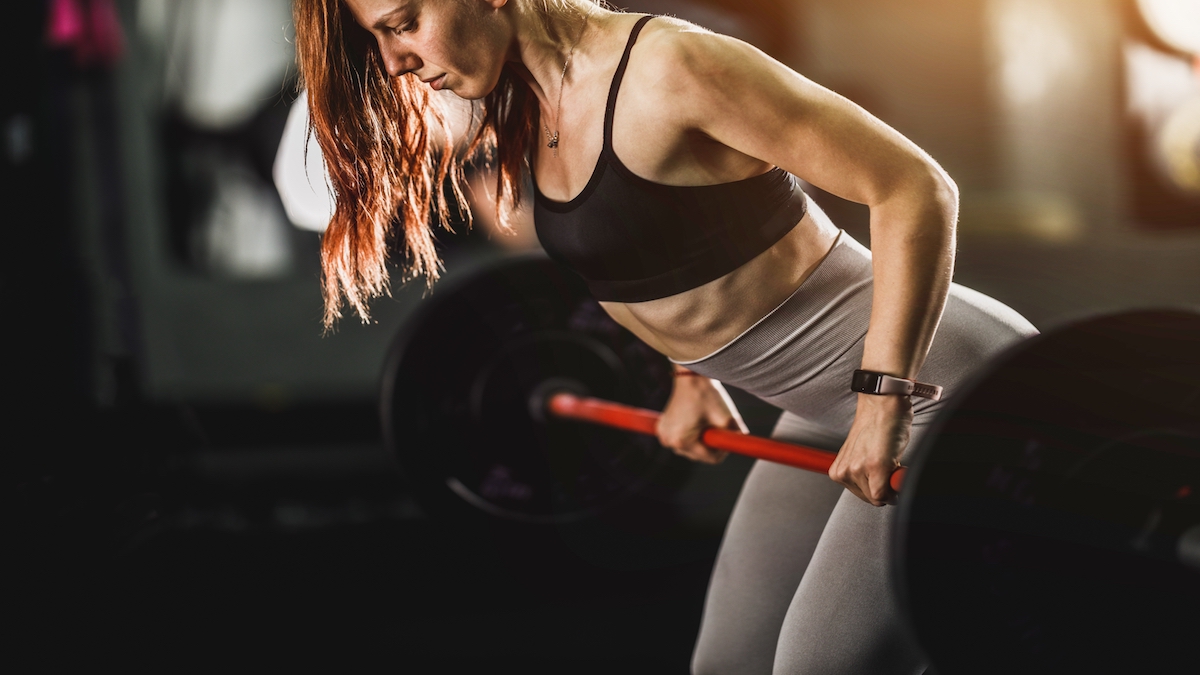Products You May Like
They say, “you gotta row to grow.” And what they’re (almost always) referring to is the big, basic, bent-over barbell row. The barbell row is one of the most challenging exercises you can you implement into your back workouts.
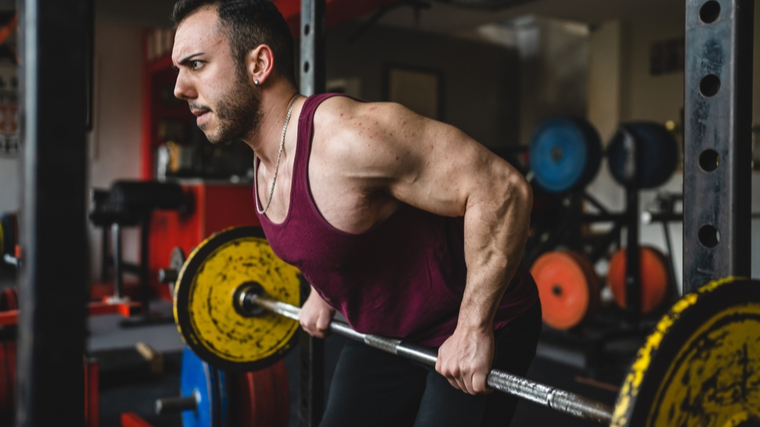
The barbell row is often considered one of the most fundamental exercises, right up there with the Big Three powerlifts — squat, bench press, and deadlift — because it’s a comprehensive movement for building a base of size and strength. It helps you build a thicker, wider, stronger back while also developing a bigger, stronger set of arms. Here’s how to get the most from this back-training staple.
How to Do the Barbell Row
The bent-over barbell row can be a very simple exercise to set up and perform. All you need is a barbell, some weight plates, and a floor. Accessories like lifting straps to support your grip strength or a lifting belt to provide additional lower back support aren’t always required.
Master the exercise itself, and then consider adding equipment depending on your specific needs and requirements.
Step 1 — Get Into the Starting Position
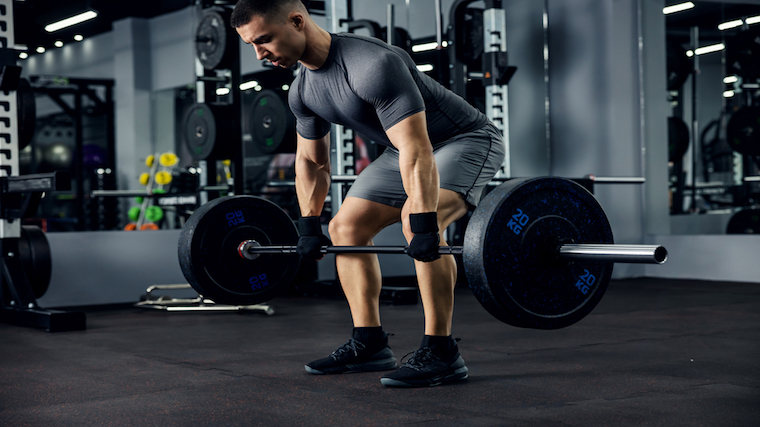
Walk up to a loaded barbell and position your feet shoulder-width apart or slightly inside hip-width. The bar should be generally over the middle of your feet. If you are quite tall, you may be more comfortable with the bar positioned against your shins.
Push your hips back and bend at the waist. Keep your back straight and your knees slightly bent. Hold the barbell with an overhand (palms down) grip just outside of your shins. Pull your shoulders back and feel tension in your lats (back muscles) as you prepare to take control over the weight. Keep your head in a neutral position — not looking at the ceiling or tucking your chin down.
Straighten your legs and stand up straight, much like you would in a deadlift. From the locked out position, bend your legs slightly and hinge at your hips until your upper body is slightly above parallel to the ground. Allow the barbell to hang near your legs with your arms extended.
Form Tip: Keep your eyes fixed on a spot roughly one to two meters (three to six feet) in front of you. This will help you maintain a stable body position, encourage consistent bar position between each rep, and reduce the risk of injury due to technical failure.
Step 2 — Pull the Weight Up
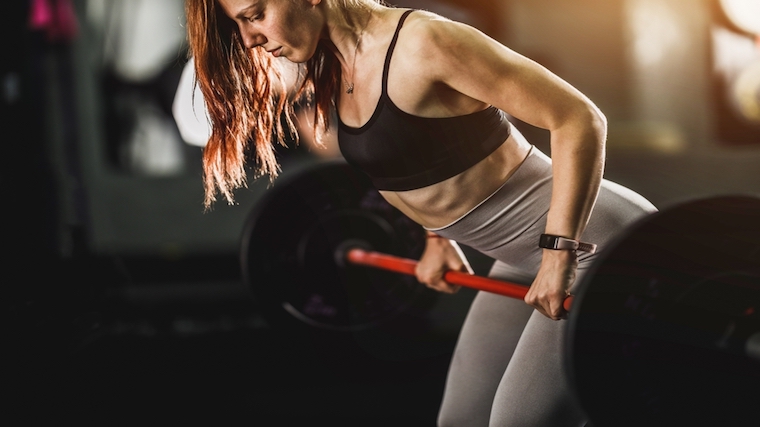
With the bar in a dead-hang position, drive your elbows up towards your hips. The barbell should reach your belly button. Once you get into the top position, focus on your shoulder blades squeezing together and feeling a hard contraction in your back musculature.
Your upper body should remain mostly horizontal throughout the rep. Avoid using your legs to “jumpstart” the weight and don’t allow your torso to drop down to meet the barbell.
Form Tip: It is important to recognize when you begin sacrificing technique for heavier weight. Key indicators that you’ve gone too heavy include: your elbows flaring out to the sides, the bar no longer reaching your belly button, or feeling extra pressure through your lower back which prevents you from holding a strong, stable torso position.
Step 3 — Lower the Weight to Stretch
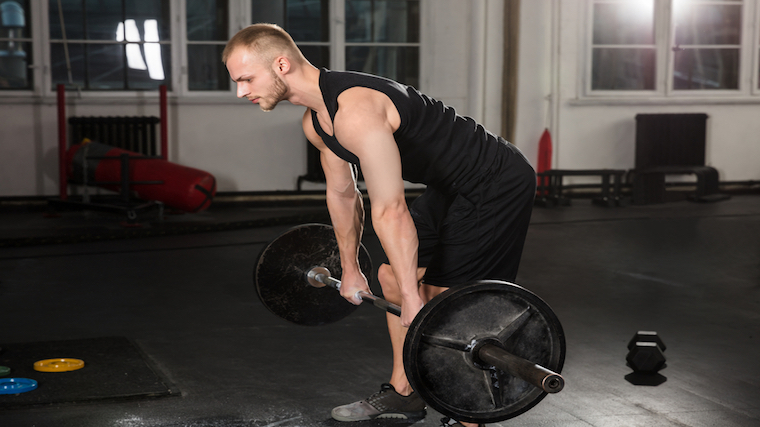
Once you have completed the concentric (lifting) portion of the movement, remain in a strong and stable position while lowering the barbell under control. Don’t allow the bar to free fall into the bottom position.
Straighten your arms and allow your shoulder blades to release from the retracted position. Feel your back musculature lengthening until your arms are fully extended.
Form Tip: Some lifters will lower the barbell too quickly and not pay attention to the bar path or muscular control. Focus on lowering the barbell in the exact same bar path as you did when lifting it. This will make sure each rep is the same and allow you to maintain tension on the back muscles while reducing the risk of injury.
Barbell Row Mistakes to Avoid
The barbell row may seem simple on paper, but you can still very easily make mistakes that may hinder your progress and training. Below are two of the most common mistakes to avoid.
Lifting with Your Arms
Many beginner lifters quickly form the habit of pulling the barbell up using their arms more than their back muscles. Sure, you can’t perform a row without using your arms at all, but proper muscle contractions should emphasize the larger back muscles more significantly than the relatively smaller muscles of the arms.
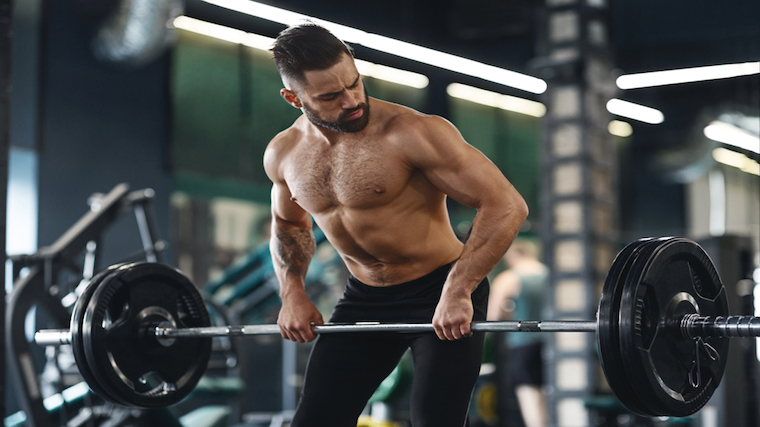
If you continue activating your arms first, as the weight increases, your arms will take over the movement and your back will be under-recruited simply because you will not have spent time focusing on feeling the back muscles contracting.
Avoid It: It is important to focus on feeling your back muscles stretch and contract. This can boost the mind-muscle connection, which has been shown to improve results. (1) If you actively drive your elbows into your hips, instead of focusing on your hands pulling the weight up, you can emphasize the lats.
Standing Too Upright
The barbell row requires you to be set in a bent-over position, or what is referred to as a “hinged position.” While your body doesn’t need to form a strict 90-degree angle, it’s imperative that you maintain some sort of stable and predominantly horizontal angle to perform the barbell row effectively.
On top of this, some trainees will use a weight that far exceeds their good-form lifting capabilities. This can lead to remaining too upright in order to counterbalance the weight, and the movement becomes more of a shrug than a row. These two factors often work hand in hand, since excessive weight and a lack of hinge stability will lead to being too upright.
Avoid It: If you have trouble maintaining a hinged position, perform the exercise near a wall and get into a hinged position with your glutes firmly against the wall. This will allow you to better leverage yourself as you improve the coordination and strength required to remain hinged while contracting your back musculature.
Benefits of the Barbell Row
The bent-over barbell row is considered a foundational exercise because it delivers several benefits for multiple muscles in the upper and lower body.
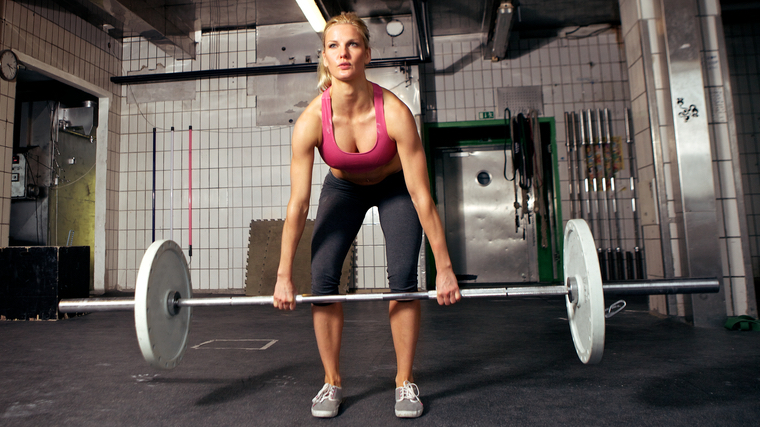
Below are some key reasons to include the barbell row into your workout regimen, whether you’re a beginner or an experienced lifter.
Improved Spinal Stability and Posture
A common weakness for lifters in the ability to maintain a neutral spine (flat back) during many movements. The barbell row helps to improve postural control in basic positions, which can carry over to strength and stability in other movements. It also strengthens postural muscles like the spinal erectors, which are a key muscle group for lower back health and stability.
Building a Stronger Back
As your back gets stronger, your ability to brace your upper body will improve. This allows greater overall stability during movements like the overhead press, bench press, and squat.
The barbell row is one of the most efficient ways to build upper-body strength because it coordinates strength through the lats, upper back, lower back, shoulders, arms, and grip. Compared to other variations of rowing exercises, the barbell row allows you to potentially use more weight, which also makes it a more effective strength-builder.
Increased Back Size
Building a wider, thicker back is one of the most efficient ways to improve your physique. The lats are one of the largest muscles on the body and a well-developed upper back can’t often be hidden under clothes, unlike well-developed arms or legs. Making the barbell row a mainstay in your back workout is a time-tested way to pack on size.
Muscles Worked by the Barbell Row
The barbell row is a compound exercise, which means it involves multiple muscles moving across multiple joints to perform the movement.

The primary muscles recruited are throughout the back, while secondary muscles, such as the biceps and forearms, are also called upon.
Latissimus Dorsi
The lats form the majority of your back musculature and are the primary muscle you will be stimulating during the bent-over row. Your lats work to bring your upper arm from in front of your body, or above it, to along your side. This function is why the cue of “pulling your elbows toward your body” helps to recruit the lats.
Spinal Erectors
The spinal erectors run the length of your spinal column, including the section most commonly called “the lower back.” During the bent-over barbell row, your spinal erectors are recruited to stabilize your spine and prevent rounding while you maintain the hinged position.
Because your spinal erectors are required to hold a stable position for the duration of each set, lifters with pre-existing lower back issues often have trouble performing barbell rows and typically choose an alternate exercise.
Scapular Stabilizers
The scapular stabilizers found across the upper back include multiple muscles working in related roles. Your trapezius, rhomboids, rear deltoids, and teres control actions such as bringing your shoulder blades together and apart, as well as moving them up and down.
This occurs while rowing the bar up and squeezing your shoulder blades together (retraction) and when lowering the barbell back to the start position, releasing (protracting) your shoulder blades.
Glutes and Hamstrings
In a hinged position, your glutes and hamstrings support your body isometrically, much like your spinal erectors work to maintain a stable upper body posture. Many lifters feel a significant stretch in their hamstrings or glutes during a set of barbell rows because the muscles are being worked in a stretched position without a full contraction.
Biceps
The biceps are recruited any time the arm flexes (bends). During the barbell row, your biceps play an assistance role to lift the weight. Your biceps can be more significantly recruited by using an underhand (palms-up) grip, which places them in a more advantageous position to be activated.
Forearms
The wrist extensors along the top of the forearm and the wrist flexors on the bottom are both highly activated during barbell rows to support a strong grip on the bar. Your flexors, in particular, are recruited to stabilize the weight as it is lifted.
For many experienced lifters lifting heavier weights, the gripping strength of the forearm muscles can be a limiting factor during rows, which is why lifting straps may be used to provide additional support.
Who Should Do the Barbell Row
Whether you are training for strength, power, or aesthetics, the barbell row can benefit your training goals. Here are more convincing reasons to include the barbell row in your back workout.
Physique-Focused Lifters
Bodybuilders, physique athletes, and any lifter wanting to look more muscular can benefit from the barbell row. It applies muscular tension to all muscles of the back and has the potential for moving heavy loads, which can be an effective way of triggering muscle growth. The barbell row has been an essential back exercise for some of the best-built physiques.
Strength Athletes
Strength athletes can benefit from using the barbell row to build pulling strength as well as total-body stability. The barbell row builds strength that supports upper body pressing and pulling. The lower back and postural stability can also help to improve strength during squats and deadlifts.
How to Program the Barbell Row
The barbell row is a foundational movement which can accommodate a variety of rep ranges, suitable to all lifters, goals, and programs. Below are two common and effective recommendations based on your specific training goal.
Heavy Weight, Low to Moderate Repetitions
If maximizing strength is your goal, three to five sets in the four to eight rep range is a good place to start. Use a weight that allows you to leave at least two reps left “in the tank” to ensure optimal technique. Rowing extremely heavy weights to muscular failure can add stress to the spinal erectors and increase the risk of injury.
Moderate Weight, Moderate Repetitions
If maximizing muscle growth is your goal, three to four sets in the six to 12 rep range is the ideal rep spread you should be targeting. This will provide you with a bump in training volume, which is beneficial for building muscle. (2) The increased volume with relatively lighter weight also allows you to develop better muscle coordination, and can eventually lead to better recruitment of the back musculature.
Barbell Row Variations
The bent-over barbell row is a versatile and fundamental exercise, but not all lifters are prepared for the challenge. Below you will find related variations that deliver comparable results with slightly varied muscle recruitment or technique.
Yates Row
The Yates row was popularized by one of the greatest bodybuilders of all time, six-time Mr. Olympia Dorian Yates. The idea behind this exercise variation was to have a slightly more upright posture while also flipping your grip to a supinated position (underhand). These adjustments better recruit the upper back, traps, and biceps.
The key to this exercise is the bar path and torso stability needed to maximally recruit the muscles being targeted. You want to focus on the barbell being as close to your thighs as possible as you pull up through your elbows.
T-Bar Row
For this exercise, you will either need a dedicated T-bar row machine or you can take a close-grip handle from the cable station and use it with a barbell set inside a landmine attachment.
The T-bar row is less demanding on the lower back, which makes it a great exercise to emphasize the rest of the back muscles. It’s ideal at the tail-end of your workouts to fully exhaust all remaining muscle fibers that were recruited during your workout.
Single-Arm Dumbbell Row
One of the most common variations of the barbell row is its dumbbell counterpart. The single-arm dumbbell row allows you to work one side of the body at time and provides stability, which reduces lower back stress. The increased stability also allows you to focus on achieving a longer range of motion to more thoroughly work the target muscles.
This is an effective movement to strengthen muscular imbalances by targeting one side of the back at a time.
Barbell Row Alternatives
Feeling like you have fully exhausted your ability to continue progressing the barbell row or just need a change of pace? Here are some of the most effective alternatives to continue building back size and strength.
Inverted Row
The inverted row is an ideal bodyweight exercise alternative for the barbell row since you can train the same muscle groups in the same movement pattern. It also only requires your body weight to provide a stimulus for muscle growth and strength-building.
This can be useful as a primary exercise if you are first starting out on learning to coordinate your muscle recruitment in the barbell row or, for more experienced lifters, at the end of your workouts as a finisher after completing your heavier weight training earlier in the workout.
Seal Row
The seal row, sometimes called a bench pull, is a chest-supported row variation that entirely removes the need to hinge. Because you’re lying prone on an elevated bench, you can more effectively isolate the larger back muscles without recruiting your lower back or lower body.
This alternative provides less stress and tension on the lower back and hamstrings, but it also means the amount of weight lifted may be less than what you could use with a conventional barbell row.
Pendlay Row
The Pendlay row is often confused with the basic barbell row for good reason. The technique, muscle recruitment, and general movement pattern is nearly identical. The key difference is that each repetition of the Pendlay row begins from complete dead-stop on the floor.
This pause between reps assists in maintaining proper positioning, minimizes any momentum, and helps to develop explosive power. This can be a great alternative if you find it difficult to remain set in a proper hinged-position, because you can reset your position between each rep.
Meadows Row
The Meadows row was popularized by legendary bodybuilding coach John Meadows. In this exercise, you are able to increase your range of motion by adjusting your hip and torso position.
The unique body positioning and leverage from the landmine will work the back musculature from a slightly different angle, reduce stress on the lower back, and minimize momentum.
FAQs
I feel my upper back working more than any other muscle, what am I doing wrong?
There are two possibilities. The first is that you may be using too much weight, causing you to stand more upright and shift muscular stress away from your lats and onto your upper back and traps. The second potential issue is that you are not properly set in a strong and stable hinged position.
Reduce the weight and focus on feeling your lats contract during the exercise. Also spend some time focusing on getting into a good hinge position — push your hips back and maintain a more horizontal upper body position for the duration of the set. Slowly increase weight over time once you are strong enough to maintain a stable torso in a hinged position.
Can beginners perform the barbell row?
Absolutely. Beginners can benefit greatly by including the barbell row in their programming. However, it is important to note that if you are a beginner, remember to prioritize technique over added weight and do not hesitate to seek assistance with your technique from a qualified staff member in your local gym.
Row Until You Can’t Row No More
Many of the all-time great bodybuilders, powerlifters, and strength athletes have built admirable backs by prioritizing the barbell row. It trains every muscle in your back, and builds strength and stability which carries over to other big lifts. It can also be a satisfying exercise to master once you’re able to walk up to an imposing barbell and pull it off the ground.
References
- Calatayud, J., Vinstrup, J., Jakobsen, M. D., Sundstrup, E., Brandt, M., Jay, K., Colado, J. C., & Andersen, L. L. (2016). Importance of mind-muscle connection during progressive resistance training. European journal of applied physiology, 116(3), 527–533. https://doi.org/10.1007/s00421-015-3305-7
- Schoenfeld, B. J., Contreras, B., Krieger, J., Grgic, J., Delcastillo, K., Belliard, R., & Alto, A. (2019). Resistance Training Volume Enhances Muscle Hypertrophy but Not Strength in Trained Men. Medicine and science in sports and exercise, 51(1), 94–103. https://doi.org/10.1249/MSS.0000000000001764
Featured Image: MilanMarkovic78 / Shutterstock
